Pair of jars and covers with mounts jars: 1670-90, mounts: early 18th century
Porcelain painted in Kakiemon-style enamels with gilt bronze | 37.5 x 14.5 x 14.5 cm (whole object) | RCIN 39238
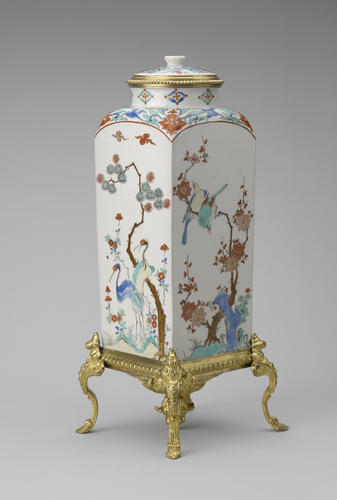
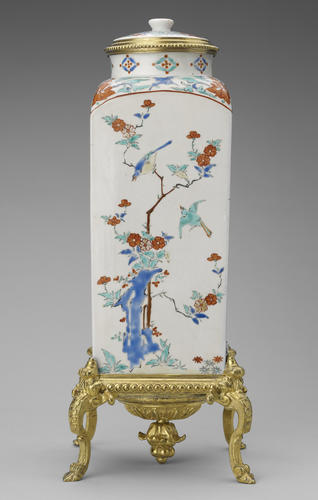
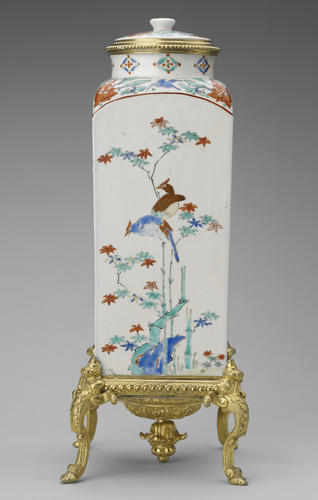
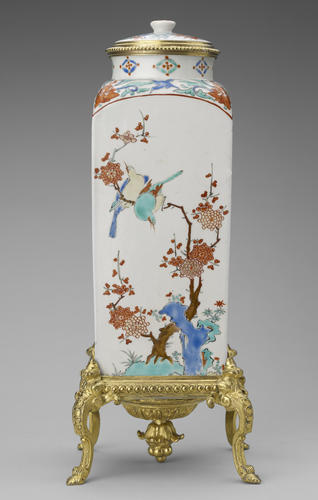
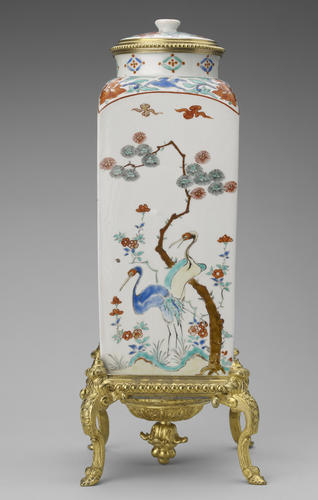
-
A pair of Japanese porcelain bottles with French gilt-bronze mounts. Tall, straight-sided, square bottles, with rounded shoulder and short round neck; the almost flat cover with a button knob. They are painted with a different design on each face: first, a pair of birds on a branch of chrysanthemums by a rock; second, two cranes perched in a pine tree with brown trunk; third, a bird on a camellia plant by a blue rock; and fourth, two crested birds perched on a slender stem of bamboo. Round the shoulder are flower sprays in red at each corner, with blue birds between, and on the neck, a border of precious jewels repeated. The cover repeats the shoulder design.
Each rim and cover is mounted in a reeded and beaded gilt-bronze band. The square base is set in a moulded gilt-bronze band, with a guilloche border on a pounced background; at each corner project four cabriole legs, with five descending shells below an acanthus spray, the lower part of the leg formed of a leaf, ending with a scroll and foliate tip. The sides of the legs (which are of square section) with pounced panels, surrounded by a burnished ground. The underside of the base mount, which takes the form of a cover found on other vases in the Collection (see RCINs 39203.1-2, 35308.1-2), with a moulded strapwork border ring with pounced ground, encircling a circular inverted dome with radiating husks divided by lambrequin-patterned ribs, centred by a berried acanthus finial.
Japanese flasks of this form, found in Namban export lacquer of the Momoyama period (1573–1615), were based on European models in glass which were carried by Spanish galleons trading to Europe in cased sets of six. A hexagonal pair (similar to RCIN 39236.1-2) and a square pair of vases, with decoration almost identical to that of the present pair, but with considerably richer mounts, were in the collection of Louis-Henri, duc de Bourbon, now in the Louvre. The square vases were noted in the inventory taken after his death, as well as the furniture listing of the château de Chantilly drawn up in 1753: Deux vases quarrés de porcelain ancienne de couleurs garnis et montés sur leurs pieds et trépieds de Bronze doré d’or moulu prisée ensemble 120 livres (‘Two square vases of old coloured porcelain, mounted on feet and tripods of gilt bronze, taken on together 120 livres’); another pair, with elaborate mounts in part by Vulliamy, is in the Royal Collection, RCIN 2337.1-2.
Japanese porcelains of the late seventeenth century painted in this harmonious and colourful palette are generously represented in the Royal Collection, especially at Hampton Court Palace (see RCINs 1094.1-2, 1178.1-2, 1050.1-2, 1047.1-2, 1110.1-2). They were perhaps the most admired of all imported wares of their time, and in consequence were extensively copied, first at Meissen in Germany, and thereafter at many other early porcelain factories in Europe.
Text adapted from Chinese and Japanese Works of Art in the Collection of Her Majesty The Queen: Volume II.Provenance
Almost certainly George IV. recorded at the Royal Pavilion, Brighton, in House No. 8, as ‘A pair of square Canister Jars & Covers, enamelled Trees, Flowers & Birds ormolu rims, bases and scroll feet, fifteen inches [38.1 cm]’ (1829B, p. 101); sent to Buckingham Palace in March 1847 (1829A, p. 33). Noted in the ‘1866’ Windsor Castle Inventory in the State Apartments Picture Gallery (now known as the Queen’s Drawing Room), pp. 412–13, no. 740. Again recorded at Windsor Castle in the Picture Gallery in April 1914, in the Brighton Pavilion Inventory of Clocks and China 1828, p. 123.
-
Creator(s)
(nationality)(metalworker)Acquirer(s)
-
Medium and techniques
Porcelain painted in Kakiemon-style enamels with gilt bronze
Measurements
37.5 x 14.5 x 14.5 cm (whole object)
Category
Object type(s)
Other number(s)







